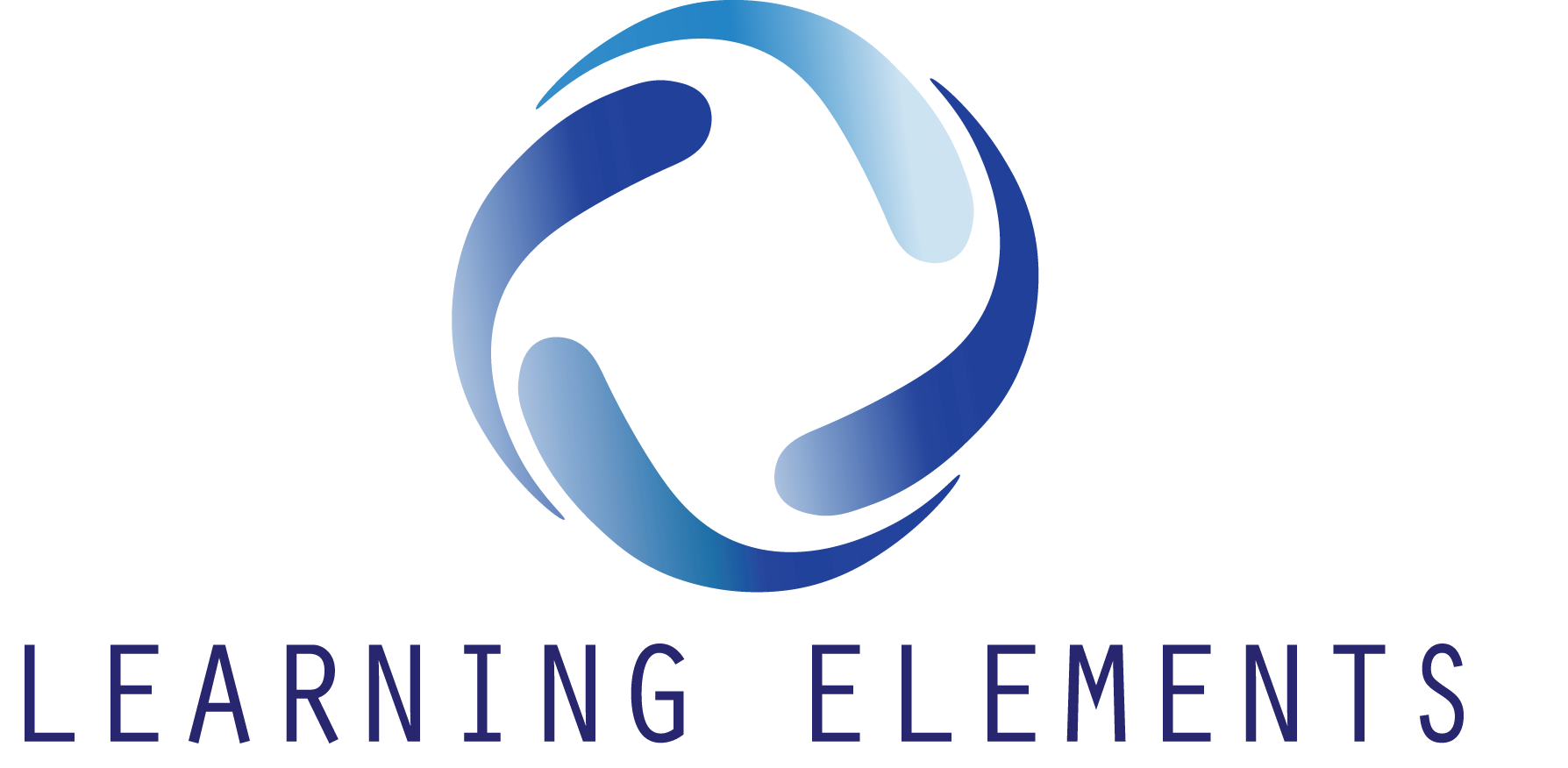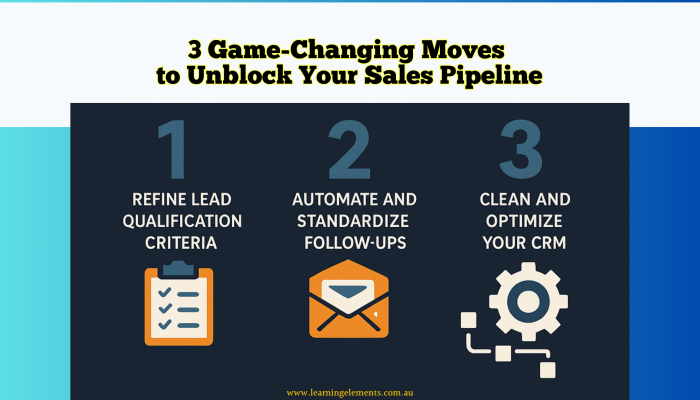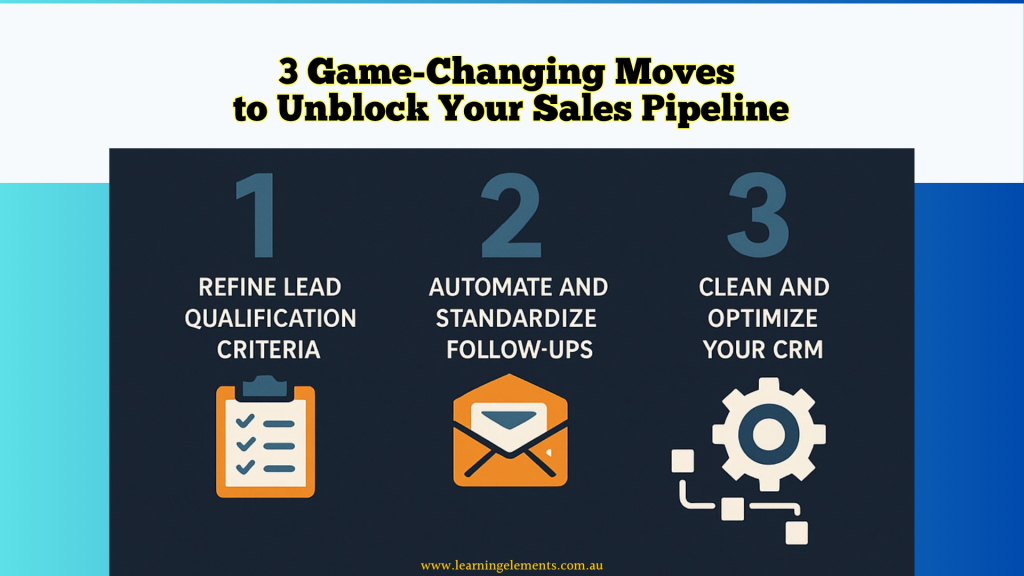Why Your Sales Pipeline Is Stuck — and the 3 Game-Changing Moves to Unblock It
Is your sales pipeline full—but nothing seems to be moving?
You’re not alone.
A clogged or sluggish sales pipeline is one of the most common—and costly—challenges in B2B sales. Deals get stuck. Leads go cold. Forecasts miss the mark. And your team wastes time chasing opportunities that never close.
But here’s the truth:
A stuck sales pipeline isn’t a result of bad luck. It’s usually the result of fixable gaps in qualification, follow-up, or process alignment.
In this article, we’ll unpack why your pipeline might be stalled—and walk you through three game-changing strategies to get it flowing again. Whether you’re leading a high-growth sales team or just trying to close more deals with less friction, this is the reset your pipeline needs.
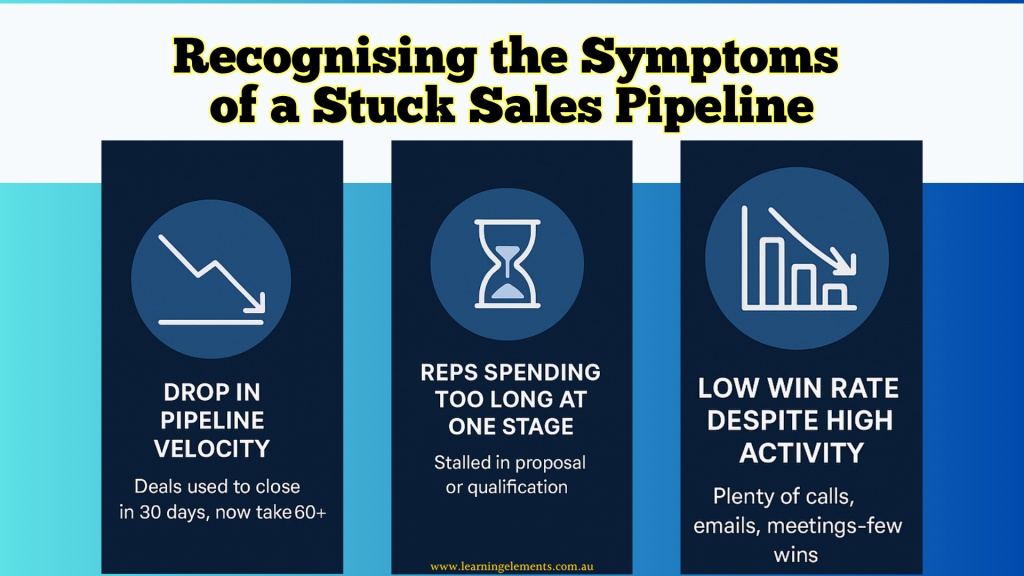
Recognising the Symptoms of a Stuck Sales Pipeline
Your CRM is full of leads. The calls have been made. Follow-up emails are out. And still… the deals aren’t closing. Sound familiar?
A stuck sales pipeline is more common than you think—and more damaging than most realise. Because when deals stop progressing, it’s rarely about effort. It’s about misalignment, missed signals, or messy processes that slow everything down—costing you time, confidence, and revenue.
These slowdowns don’t always announce themselves. But they do leave a trail. If you know what to look for, your pipeline will start telling you where it’s blocked. Here are three of the most common—and often overlooked—warning signs that your sales pipeline is stuck.
–Drop in Pipeline Velocity
Deals that used to close in 30 days now take 60 or more. That’s a red flag! A drop in pipeline velocity often signals delayed decision-making, lack of urgency, or misalignment with the buyer’s journey. When deals stall at multiple points, your forecast becomes unpredictable—and that affects hiring, budgeting, and planning downstream.
–Reps Spending Too Long at One Stage
Are your reps bottlenecked in the proposal or qualification stage? That’s a classic sign of friction. Maybe the lead wasn’t truly qualified. Maybe your messaging doesn’t land. Or maybe the next step isn’t clearly defined. Regardless, time kills deals—and every extra day a deal lingers increases your risk of losing it altogether.
–Low Win Rate Despite High Activity
Your team’s making the calls. Emails are going out. Meetings are booked. But the close rate stays low. That doesn’t mean your reps are slacking—it likely means your pipeline process is broken. If you’re burning energy on leads that don’t convert, you need to re-examine your targeting, sequencing, or scoring model.
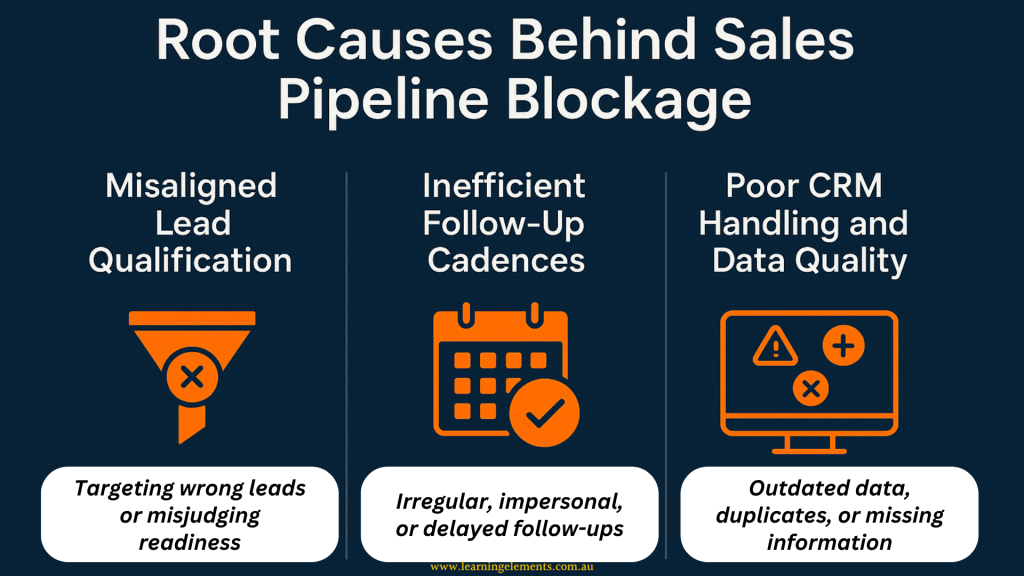
Root Causes Behind Sales Pipeline Blockage
Let’s cut to the chase: your pipeline problems likely come from one (or more) of these core issues. These aren’t surface-level hiccups—they’re structural gaps that quietly stall deals and derail momentum.
Misaligned Lead Qualification
If you’re speaking to the wrong people—or the right people at the wrong time—you’re wasting valuable time and budget. When your lead qualification process is based purely on job titles or basic firmographics, you’re likely to miss the deeper indicators of buyer readiness.
Misaligned lead scoring is a silent killer of conversion rates. It floods your pipeline with deals that look good on paper but don’t progress. If your sales team keeps hearing “not now” or “we’re not ready yet,” chances are you’re qualifying based on assumptions—not intent.
Fix it by refining your Ideal Customer Profile (ICP), implementing a scoring model that reflects behavioural signals (like webinar attendance or content engagement), and ensuring marketing and sales agree on what a qualified lead actually looks like.
Inefficient Follow-Up Cadences
Deals don’t die from rejection—they die from neglect. According to HubSpot and other sales research platforms, the average B2B sale requires 8 to 12 touchpoints, yet most salespeople give up after just 2–3 attempts. That means promising leads go cold not because they weren’t interested—but because they weren’t followed up with at the right time, in the right way.
Irregular, impersonal, or one-size-fits-all follow-ups break trust and fail to build urgency. Worse, they signal to your prospect that you’ve forgotten them or weren’t serious to begin with.
Solve this by creating automated multi-touch cadences with personalised content at each stage of the buyer’s journey. Use sequencing tools like HubSpot or Salesloft, and layer in value-driven messages—case studies, industry insights, or ROI examples—to keep engagement high.
Poor CRM Handling and Data Quality
Your CRM should be your team’s single source of truth. But if it’s riddled with duplicate entries, outdated contacts, missing fields, or ambiguous deal stages, it becomes a source of confusion—not clarity.
Sloppy data handling causes reps to waste time chasing the wrong leads, misinterpret deal status, or forget next steps entirely. It also leads to faulty forecasting, eroded confidence in reporting, and a pipeline that looks healthy—until it suddenly isn’t.
Improve this by conducting regular data audits, enforcing field standards (like mandatory ‘next step’ updates), and removing dead opportunities or old contacts. Consider assigning ownership of CRM cleanliness within your team, and schedule monthly hygiene checks to keep everything sharp.
Need help choosing the right CRM or optimising your current setup? If CRM setup or qualification strategy feels overwhelming, talk to a sales consultant to get immediate feedback on your pipeline.
Buyer Journey Awareness Alignment
For sales leaders or pipeline owners, it’s critical to ask—are your stages aligned with how buyers actually make decisions? One of the most overlooked reasons your sales pipeline may be underperforming is a misalignment between your sales stages and the modern buyer’s journey. Today’s B2B buyers are more informed, digitally empowered, and often self-educate before ever engaging with sales.
Yet, many sales pipelines are still structured around the seller’s process, not the buyer’s decision-making flow.
Here’s the disconnect:
| Traditional Sales Stage | Modern Buyer’s Thought Process |
|---|---|
| Lead Qualification | “I’m still defining my problem.” |
| Needs Analysis | “I’m comparing options online.” |
| Proposal/Presentation | “I’ve read three whitepapers already.” |
| Negotiation | “Now I want internal stakeholder buy-in.” |
Consider whether your current stages, like ‘proposal sent’ or ‘needs analysis,’ match what your buyers are actually doing at that point—like gathering internal approvals or comparing solutions. For example:
- Replace “Initial Contact” with “Discovery + Education” phase.
- Rename “Proposal” stage to “Collaborative Solutioning” if that’s how buyers expect to engage.
Aligning your pipeline stages with the buyer’s actual journey improves forecasting accuracy, win rates, and rep efficiency. More importantly, it keeps your team focused on the buyer—not the process.
For strategy leads, these insights shape how you structure the pipeline. For reps, this helps interpret what a prospect’s actions actually mean.
To further understand the Essential Stages of a Sales Pipeline, read our full article here.
The True Cost of Sales Pipeline Stagnation
A slow or stuck pipeline doesn’t just delay deals—it impacts every part of your revenue engine. The effects are often gradual but cumulative, and they’re rarely felt in isolation. Here’s what’s really at stake:
Lost Revenue Opportunities
Every week a qualified lead sits idle, their interest fades, your competitors gain ground, and revenue potential shrinks. In many B2B sales environments, timing is everything. If you’re not moving with urgency, someone else is. Pipeline stagnation leads to missed windows of opportunity, especially for mid-funnel deals where buyer intent is high but action isn’t taken quickly enough.
Example: A delayed follow-up after a product demo can be the difference between closing a A$30,000 deal—or losing it to a faster-moving competitor.
Burned Out Sales Teams
When sales reps consistently chase low-fit leads, revisit the same stale opportunities, or spend hours cleaning up CRM records, frustration sets in. Over time, motivation drops, effort becomes scattered, and top performers disengage.
Pipeline blockages don’t just slow down deals—they slow down people. Your team’s energy should go toward meaningful conversations and high-probability closes, not guesswork and admin noise.
The impact: Burned-out teams close fewer deals and experience higher turnover, which only compounds the pipeline problem.
Missed Forecasts and Reporting Errors
Accurate forecasting relies on up-to-date, stage-accurate data. But when your pipeline is cluttered with outdated opportunities or misaligned deal stages, forecasts become unreliable. That misguides leadership decisions around hiring, cash flow, and campaign planning.
You can’t plan for growth if you can’t trust your numbers. Worse, misreporting causes internal friction between departments—especially sales, marketing, and finance—who depend on pipeline insights to make strategic calls.
What that means: Inaccurate forecasting due to pipeline blockages can result in overspending, missed sales targets, and a loss of executive confidence in the sales function.
3 Game-Changing Moves to Unblock Your Sales Pipeline
These three actions can revive even the most sluggish pipeline—quickly, effectively, and without overhauling your entire system. If your deals are stalling, these are the levers worth pulling.
1. Refine Lead Qualification Criteria
Most pipeline slowdowns start with bad-fit leads clogging the top. When you’re filling your pipeline with prospects who aren’t ready, relevant, or capable of buying, it creates false volume and false confidence.
You’ll end up wasting time on follow-ups that go nowhere and proposals that never get approved.
Implement a Proven Framework Like MEDDIC or BANT
- MEDDIC ensures a deep understanding of the buyer’s decision process.
- BANT helps quickly identify budget-ready, authority-backed leads.
Both frameworks sharpen your focus and remove ambiguity in early conversations. When applied properly, they reduce time-to-close and increase win rates.
Align your sales and marketing teams around these definitions for better-qualified opportunities. Everyone should agree on what a “good lead” actually looks like—so you can filter smarter, engage sooner, and close faster.
2. Automate and Standardise Follow-Ups
Your best lead might not convert because they didn’t get that second or third nudge. Even if the intent is there, a delayed or inconsistent follow-up can cause deals to cool off—or worse, disappear completely.
Use Sequences, Reminders, and Email Tracking
Tools like HubSpot, Outreach, and Salesloft let you build multi-step sequences with reminders, open notifications, and link tracking to maintain momentum. You can customise timing, personalise touchpoints, and track which actions actually move deals forward.
When follow-up becomes automatic and consistent, you reduce risk, build trust, and stop missing opportunities just because someone forgot to send the next message.
3. Clean and Optimise Your CRM
Your CRM should be a performance booster—not a bottleneck. When well-maintained, it empowers reps with clarity, not confusion. But if your data is messy, your stages are unclear, or your fields aren’t updated, the pipeline quickly becomes a black hole of guesswork.
Audit Stages, Update Tags, Eliminate Duplicates
- Remove outdated or dead opportunities that no longer belong in your forecast.
- Standardise fields like “deal stage” and “next steps” so reps know exactly where each opportunity stands and what action is needed next.
- Create reports that highlight pipeline gaps before they grow—giving sales managers visibility, and leadership confidence in the numbers.
An optimised CRM creates flow, visibility, and accuracy—so your team can sell smarter, not harder.
Need expert eyes on your current pipeline?
Book a free 30-minute pipeline review session. We’ll walk through your current stages, tools, and blockers—and recommend smart, fast fixes.
Strategic Enhancements: 3 Moves to Maximise Sales Pipeline Flow
1. Improve Lead Scoring and Segmentation
Not every lead is sales-ready—or aligned with your ideal customer profile. Basic demographic info isn’t enough anymore. You need to segment based on behavioral triggers, persona type, deal size, lifecycle stage, and level of engagement.
- Use tools like HubSpot or Clearbit to enrich data.
- Build dynamic lead segments that adjust in real time.
- Assign point values for activities (e.g., downloaded a whitepaper, attended a webinar).
This ensures your reps focus on high-intent buyers, not just inbound form fills.
2. Streamline Follow-Up Processes
Too many promising deals stall due to inconsistent or slow follow-up.
- Create automated multi-touch email cadences that span days or weeks.
- Use calendar integrations like Calendly to reduce back-and-forth when scheduling.
- Leverage task reminders, call queues, and AI-driven recommendations to keep reps on track.
Standardising follow-ups helps move deals forward systematically and reduces human error.
3. Revisit and Refresh Sales Messaging
Your buyer’s challenges evolve—has your sales messaging kept pace?
- Update email templates and talk tracks based on recent objections or competitor shifts.
- Customise outreach based on industry-specific pain points.
- A/B test subject lines and calls-to-action for open and reply rates.
A well-timed, relevant message can revive a stalled opportunity that might otherwise be lost.
Bonus Tips to Keep the Sales Pipeline Moving
- Schedule Weekly Pipeline Reviews with managers and reps.
- Set KPIs for stage movement, not just revenue.
- Ensure Marketing and Sales Alignment with clear handoff criteria.
These habits prevent future clogs and ensure smooth flow.
Example of Pipeline Management: From Stalled to Streamlined
We recently worked with a mid-sized B2B SaaS company in Australia that was experiencing pipeline stagnation. Their average deal age had stretched from 22 to 47 days, revenue had dipped, and sales morale was noticeably low.
Here’s what we helped them change:
- Rebuilt their lead scoring model using recent buyer behaviour and intent data
- Rolled out new, multi-step automated follow-up cadences
- Conducted a full CRM clean-up, including field standardisation and team training
The result? Within a quarter, their pipeline velocity increased by over 40%, and they saw a strong rebound in closed deals.
“Learning Elements helped us navigate a major logistics shift and sharpen our lead scoring fast—we saw real, measurable results in just one quarter.”
— Claire Johnson, Head of Sales Operations
Feeling stuck or unsure how this applies to your pipeline?
You’re not alone—and we can help… Let’s talk through it, just like we did for this team.
Metrics That Reveal Sales Pipeline Health
Track these KPIs weekly:
| Metric | What It Shows |
|---|---|
| Pipeline Coverage Ratio | Enough opportunities to hit quota? |
| Average Deal Age | Are deals lingering too long? |
| Conversion Rate by Stage | Where are leads dropping off? |
Use these to pinpoint blockages and respond fast.
Micro-Conversions Between Pipeline Stages
When building a sales pipeline that converts consistently, you can’t afford to rely solely on big milestones like “Demo Booked” or “Contract Sent.”
Instead, look for micro-conversions—small but meaningful actions that show your prospect is progressing through the funnel.
Here are a few examples:
| Pipeline Stage | Micro-Conversion Indicator |
|---|---|
| Discovery / Education | Downloaded a case study, attended a webinar |
| Needs Analysis | Completed a survey or pain point form |
| Proposal / Solutioning | Engaged with interactive quote, asked for customisation |
| Negotiation | Added decision-makers to next call |
These micro-conversions give your team more granular visibility and help you:
- Accurately score and prioritise deals
- Trigger relevant follow-ups at the right time
- Reduce drop-off between stages
You can track these interactions via your CRM, marketing automation tools, or sales enablement platforms. Some platforms even trigger alerts or workflows based on micro-conversion events.
Don’t wait for ‘big’ actions to qualify pipeline movement—embrace the small signals that indicate real interest.
FAQs
1. What’s the most common reason a sales pipeline gets stuck?
The two biggest culprits are poor lead qualification and inconsistent follow-up. Many pipelines become clogged when reps chase leads who aren’t truly sales-ready or forget to follow up effectively. The Learning Elements team helps by auditing your qualification criteria and designing intelligent follow-up sequences that keep leads moving forward.
2. How often should I review and update my sales pipeline?
Ideally, you should be reviewing your pipeline weekly to keep momentum and deal accuracy in check. A more thorough pipeline audit should happen monthly, including CRM cleanliness, stalled deal tracking, and stage progression. If that sounds time-consuming, our team offers hands-on pipeline reviews and reporting frameworks tailored for your industry.
3. Should I remove old or inactive deals from the pipeline?
Yes—if a deal has been inactive for more than 45–60 days and lacks a clear next step, it should be either closed out, recycled, or re-nurtured. Keeping your pipeline clean improves forecast accuracy and keeps your team focused. We help our clients implement pipeline recycling workflows to revive old leads or close them with confidence.
4. How can automation actually help unblock a stuck pipeline?
Sales automation does more than just send follow-up emails—it can help you prioritise leads, schedule nudges based on engagement, and alert reps when deals are going cold. With tools like HubSpot, Salesforce, or Outreach, you can automate touchpoints, personalise cadences, and save time on admin. Our team can help you set up or optimise your automation tools for better deal movement.
5. What’s the fastest way to see results if my sales pipeline is underperforming?
Focused action across three areas—lead qualification, follow-up strategy, and CRM hygiene—can yield visible improvements in as little as 2–4 weeks. Our team specialises in rapid sales pipeline audits and acceleration sprints that identify the gaps, apply fixes, and give your pipeline a healthy push—fast.
Conclusion
If your pipeline feels like it’s stuck in traffic, you’re not alone—but you don’t have to stay stuck. By fixing your lead qualification, automating your follow-ups, and cleaning your CRM, you’ll unleash momentum that leads to real revenue.
It’s not about having more leads—it’s about moving the right leads forward.
Ready to fix your pipeline for good?
Let’s apply the exact frameworks we’ve used to help Australian B2B teams boost conversions by up to 30%.
